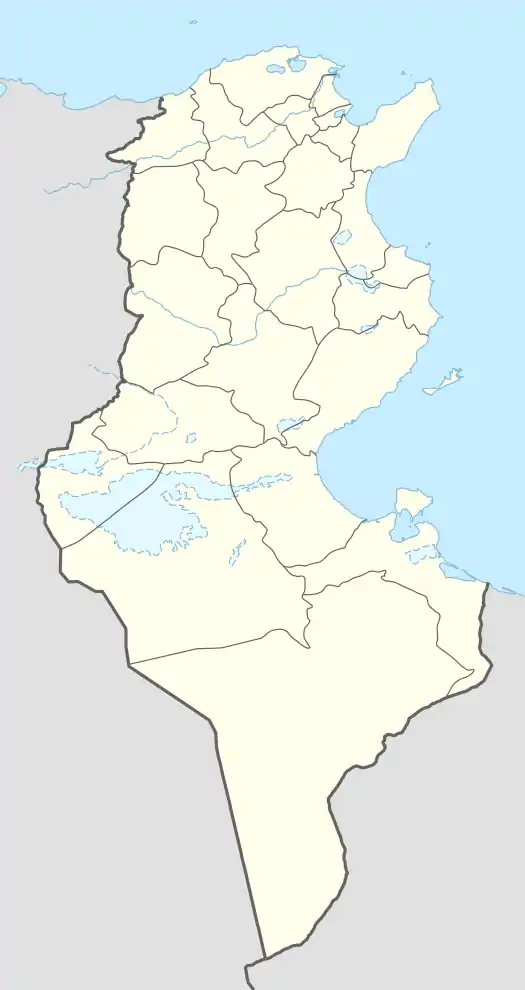Jebil National Park
Jebil is a national park in Tunisia situated within the Sahara desert. Covering an area of 150,000 hectares, it is the country's second-largest national park, after Senghar-Jebbes National Park. Though large, it is relatively new having been designated a national park in 1994 (unofficially since 1984). Until Senghar-Jebbes was declared, it was the only national park within the Sahara desert proper.[1]
| Jebil National Park | |
|---|---|
 | |
| Location | Tunisia |
| Coordinates | 32°54′4″N 9°9′25″E |
| Area | 1,500 km2 |
| Established | 1994 |
Description
Jebil National Park is located 80 km south of Douz. Its vegetation includes desert shrubs like Retama raetam, which are common in regions inhabited by gazelle, hare and horn viper. It also includes flowering grasses of the Calligonum family (Calligonum arich and Calligonum azel), as well as Arthrophytum schmittianum, Aristida pungens and the daisy flowering plant Rhanterium suavolens[2].
The park has guarded shelters for tourists who frequent the area (guards are stationed throughout the park). Research also takes place in the park, since the site is home to a number of prehistoric artifacts[3] which are studied to learn about the different stages of human history from the Holocene up to World War II.[1] The park covers nearly the entire Grand Erg Oriental within Tunisia.
In the western portion, there are 'gigantic boulders' which were formed through weathering of plutonic rocks.
Fauna
The park is home to a variety of wildlife including the fennec fox, horned viper, cobra, jackal, and the barbary sheep, which are endemic to the region.[4] The snakes and other reptiles live under rocks and in sandy depressions.
Mammals
The dorcas Gazelle Gazella dorcas (VU) and the Rhim gazelle Gazella leptoceros (EN) are both still present in the park. Cheetah Acinonyx jubatus (VU) once present has probably disappeared.[2]
Birds
The park is classified worldwide as an Important Bird Area (TN043). This is the only protected location in Tunisia where the desert sparrow Passer simplex has been recorded and one of only two at which the thick-billed lark Ramphocoris clotbey occurs.[2] The Houbara bustard Chlamydotis undulata, very rare in Tunisia and in the Vulnerable category worldwide has been found to be nesting only within the enclosed area of the Park, indicating the importance Jebil national Park for the conservation of this bird.[5]
Threats
The main threat to the site is poaching (of gazelles Gazella, of sandgrouse Pterocles and of the Houbara bustard Chlamydotis undulata).
 Algerian side of the Grand Erg Oriental
Algerian side of the Grand Erg Oriental Sahara desert, Tunisia
Sahara desert, Tunisia
References
- "Defining a World Heritage in the Heart of the Libyan Desert". August 2009.
- MOURAD AMARI, HICHEM AZAFZAF (2001). Tunisia in Important Bird Areas in Africa and associated islands: Priority Sites for Conservation, Fishpool, L. D. C. and Evans, M. I., eds (PDF). Cambridge: Pisces Publications, Birdlife International.
- "Tunisia - Nature and Wildlife". goway.com. Retrieved 2021-08-03.
- "Tunisia: Jebil National Park". Archived from the original on May 7, 2012. Retrieved December 8, 2011.
- Mohsen Chammem, Yves Hingrat, Mohsen Jarray, Eric Le Nuz, Orhant Nicolas, Abid Mohamed, Touiti Youssef, Karem Abdelhamid, Khorchani Touhami (2008). "Statut et distribution des sites de parade et des sites de nidification de l'Outarde houbara (Chalamydotis undulata undulata) dans la région de Jbil-Tunisie". Actes des journées scientifiques de l INRGREF, Hammamet 11,12 et 13 novembre 2008 la biodiversité dans les aires protégées - Annales de l INRGREF (in French).
{{cite journal}}: CS1 maint: multiple names: authors list (link)